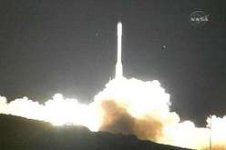Environmental Satellite of 273.4 million dollar crashes Wednesday, February 25, 2009
The satellite was to measure the concentration of greenhouse gas.
HLN update The launch of a Taurus rocket with a U.S. environmental satellite failed. The nose cone was not off the 273.4 million dollar cost Kunstmaan dumped, said John Brunschwyler, program manager of the Taurus-XL launch vehicle with rocket builder Orbital Sciences.
Problem
The Taurus-XL of Orbital Sciences was 10.55 hours, Brussels time off with the OCO satellite of NASA. Fourteen minutes after the start was not the redeeming message that the payload was turned off. A minute later came the contrary indicates that the launch was a failure, which quickly became apparent that the nose cone was off. However, the results reported, shortly after the time that this had to happen, three minutes into the flight.
Nose Cone
The nose cone consists of two halves and must be protected from the payload care in the first phase of the flight. The order results via a series of electrical pulses from an electronic box, which appears to have worked well. What exactly failure is not yet clear. Because the nose cone still in the remaining stage of the rocket stuck and extra weight was, the planned orbit in space has not been achieved. The artificial is therefore around Antarctica in the Pacific Ocean. An inquiry, the exact cause of the failure trace.
Environmental Satellite
The weighing 441 pounds, also built by Orbital, "Orbiting Carbon Observatory 'was from a near-polar orbit at 705 km altitude at least two years with three spectrometers global distribution of carbon dioxide, the main greenhouse gas, the atmosphere in check. This would happen through 8 million measurements in 16 days. A few weeks ago, but Japan successfully launched a similar satalite, the Ibuki.
Taurus
The 27 meter high Taurus using solid fuel is up and running, a light launcher three steps in common with the Pegasus Oribital of which an aircraft is launched. The Taurus has a lower extra step, and can lead to 1.59 tonnes in a low orbit off. The missile came into service in 1994, flew for the accident today launched it six times and 10 satellites. For today the rig failed only once, especially in September 2001. NASA used the Taurus-XL for the first time for a satellite launch, and would later do again this year. (Belga / sam)
Source: hln
The satellite was to measure the concentration of greenhouse gas.
HLN update The launch of a Taurus rocket with a U.S. environmental satellite failed. The nose cone was not off the 273.4 million dollar cost Kunstmaan dumped, said John Brunschwyler, program manager of the Taurus-XL launch vehicle with rocket builder Orbital Sciences.
Problem
The Taurus-XL of Orbital Sciences was 10.55 hours, Brussels time off with the OCO satellite of NASA. Fourteen minutes after the start was not the redeeming message that the payload was turned off. A minute later came the contrary indicates that the launch was a failure, which quickly became apparent that the nose cone was off. However, the results reported, shortly after the time that this had to happen, three minutes into the flight.
Nose Cone
The nose cone consists of two halves and must be protected from the payload care in the first phase of the flight. The order results via a series of electrical pulses from an electronic box, which appears to have worked well. What exactly failure is not yet clear. Because the nose cone still in the remaining stage of the rocket stuck and extra weight was, the planned orbit in space has not been achieved. The artificial is therefore around Antarctica in the Pacific Ocean. An inquiry, the exact cause of the failure trace.
Environmental Satellite
The weighing 441 pounds, also built by Orbital, "Orbiting Carbon Observatory 'was from a near-polar orbit at 705 km altitude at least two years with three spectrometers global distribution of carbon dioxide, the main greenhouse gas, the atmosphere in check. This would happen through 8 million measurements in 16 days. A few weeks ago, but Japan successfully launched a similar satalite, the Ibuki.
Taurus
The 27 meter high Taurus using solid fuel is up and running, a light launcher three steps in common with the Pegasus Oribital of which an aircraft is launched. The Taurus has a lower extra step, and can lead to 1.59 tonnes in a low orbit off. The missile came into service in 1994, flew for the accident today launched it six times and 10 satellites. For today the rig failed only once, especially in September 2001. NASA used the Taurus-XL for the first time for a satellite launch, and would later do again this year. (Belga / sam)
Source: hln


